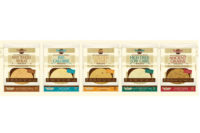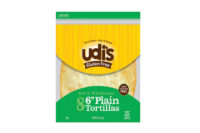Talking Tortillas and the Social Network
Flatbread and tortilla producers amplify their promotional spending and look to the social network to ensure consumers get the messages producers want them to have.







When you hear the word, “tortilla,” what typically comes to mind? Tacos? Burritos? Enchiladas? Fajitas? Quesadillas? What about wraps, flatbreads or melts?
Whether they’re fresh or frozen, eaten on their own or used as a component to a larger meal, the insurgence of tortillas and flatbreads allows consumers to have unlimited ideas as to what comes to mind when talking tortillas.
However, taking that idea and turning it into reality is another discussion. That’s why several producers are boosting their marketing and advertising dollars to ensure that their messages reach their intended audiences.
Companies such as Ruiz Food Products, Inc., for instance, “talk” to consumers through the use of merchandising, promotions, the Internet and a little help from social media.
“First, we leverage our variety and innovation through promotional support during back-to-school, Halloween, Christmas and New Year’s, Super Bowl and Cinco de Mayo, etcetera,” says Kim Ruiz Beck, chairman of the Dinuba, Calif., company. “Second, we drive interest to the El Monterey brand and its innovative products through in-store signage, floor graphics, free-standing inserts to more than 40 million homes, competitive price points of the products and active social media (with more than 250,000 Facebook fans consisting of both moms and young people).”
Ruiz Foods also offers coupons that drive trial and awareness and the opportunity to find exactly where to buy specific El Monterey products and flavors, Ruiz Beck adds.
For the Tornados brand, Ruiz Foods partnered with the National Association for Stock Car Auto Racing (NASCAR) for a multi-media promotional campaign, “with in-store merchandising materials, social and digital media, while sponsoring several races during the course of the NASCAR season,” Ruiz Beck notes.
Ruiz Foods also overlays its promotions with radio and geo-targeted social media to drive awareness to customers’ locations, Ruiz Beck says. “Our Tornados sampling promotions have been very successful driving trial while linking back to specific customers,” she adds.
For its part, Houston-based Reddy Bread turned to Facebook ads to help generate awareness and drum up additional sales.
“We are looking for people who have already tried our products and have seen the results to recommend it to their friends and family,” says Priti Shah, chief marketing officer. “Social media allows us to quickly get out any new information about our products.”
The producer of pita bread, tortillas and rotis maintains Facebook, Twitter, Stumbleupon and Pinterest pages to connect with its consumers and get the word out about new products, such as its Heart Smart Pita.
The folks at Flatout Flatbread shake up its consumer base by interacting with its more than 16,000 Facebook followers on a regular basis. The Saline, Mich.-based company shares recipes and new product launches and fields questions about where to find certain products. The Flatout Flatbread also maintains a blog called Flatout Fresh, which brings important industry topics to the forefront.
Sharing is caring
While some producers rely on the share button that most social media channels provide, others build their own sharing function, designed to invoke both innovation and interaction.
For instance, in November 2011, Mission Foods unveiled the NachoTron 3000, an interactive, competitive nacho-making machine created by “scientists” to analyze how human football fandom correlates to nacho toppings. It debuted at the 2011 Border Showdown between the Kansas Jayhawks and Missouri Tigers on Nov. 26, 2011 at Arrowhead Stadium in Kansas City, Mo.
“The Border Showdown represents the perfect blend of competitive sportsmanship and ravenous fans that NachoTron 3000 was made for,” says Pete Thornfield, director at Mission Foods. “Fans should come hungry, both for their team to win and for nachos.”
The Irving, Texas, company also encourages tortilla lovers to share and swap recipes through its online cookbook. Users can log onto www.missionfoods.com, customize their meal options based on type of entrée, ingredients and timing and locate a bevy of recipes that fit their needs. Online visitors can also create their own cookbook, which stores favorite recipes in an interactive flipbook format.
“Today’s consumers have a more sophisticated palate and are looking for a different and unique eating experience,” says Peter Thornfield, senior director of marketing for Mission.
Through social media, point-of-purchase promotions, grassroots advertising and even packaging enhancements, the flatbread and tortilla industry “speaks” to its consumers by showcasing innovative new uses, merchandising and ingredients.
Looking for a reprint of this article?
From high-res PDFs to custom plaques, order your copy today!



















